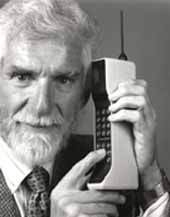
Mark this down in the “Obvious” bin: more and more cell phones are using real names in recent years. It was only a few years ago that virtually every cell phone was identified by a serial number-esque stream of numbers and letters that, while I’m sure they made plenty of sense to a company’s on-hand staff of engineers and marketing pros, were more likely to leave consumers scratching their heads.
Hence the rise of the RAZR, the Chocolate, and the Treo—instantly-recognizable brands that bring up images that have been finely crafted through millions of dollars of advertising and marketing muscle.
But there’s a logical end to this name game. And it can be summed up quite simply as “more of the same.”
It’s amazing it took companies so long to realize how off-putting it is to consumers when a product is called the JF-78XXW or whatever. I mean seriously, most people don’t even know their own Social Security number. It will be a cold day in a Sprint store before somebody walks in and says they need—NEED—the VX-998383F (or whatever). It’s just not how we roll.
Of course, these days it’s standard operating procedure that a hot new cell phone will have a catchy name. Part of this comes from an increasing share of marketing money being spent on specific phones, as opposed to merely Verizon or Cingular as a whole. The whole point of marketing is to leave a product hanging in somebody’s mind. Without a catchy name, this is impossible. But it’s also just simple logic—create a catchy name with a nice image and the money will follow
But beyond that, a cell phone’s name is extraordinarily important to these companies for a simple reason—cell phones are essentially becoming commodity products. A catchy name (and image) is a simple way of differentiating a phone from the slew of other 1.3-megapixel clamshells out there. Cell phone companies are fighting the commodification of their products tooth and nail. If all phones are viewed as identical, it’ll be all-too-easy for no-name Chinese companies to swoop in and steal Motorola’s thunder.
Lets break cell phones into two categories: “hot” phones and “commodity” phones. Hot phones have marketing money, striking designs, cutting-edge features, and real names. Just by looking at a phone’s name, you can tell if it is a commodity phone or not—if it’s name shows up in the dictionary (with or without vowels), it’s hot. Nameless commodity phones essentially fall into the “free with contract” or “I lost my phone and need the cheapest one you have today” territory.
Unfortunately for cell phone manufacturers, it’s inevitable—they will run out of decent names (or at least the low-hanging fruit.) As deep as the Oxford Dictionary is, I would say that there really is an incredibly finite supply of words that work with cell phones. The LG Chair or the Motorola GLV just don’t have that certain je ne sais pas.
So what is going to happen? Are companies sweating bullets and hiring dozens of interns to scour the dictionary for the next hit name? Hardly.
What is more likely is, as has become the case with the RAZR, names will become synonymous with DESIGN above all else. New features will come, the design may even shift a bit, but once a company stumbles onto a hit name-design combination, they will milk it for years. If LG views the Chocolate to be a home-run, they’ll throw a new one out next year with the same name and form factor, but updated features. This will save companies money in marketing (the product will already be well-known) and design (they’ll be able to recycle old molds.)
And, since we’ve essentially reached the end of the thinner-thinner-thinner phone arms race, it should be easier than ever for company’s to get away with reusing old designs.
And for you the consumer? Well, this means that you better get used to seeing the same designs pop up again and again for years and years. Don’t be surprised if cell phone companies fall into what I call the “Hollywood Trap” — that is, they get complacent and stick to what works, refusing to take risks. In this case, the only winners will be the upstarts who see an opportunity to put some interesting designs in people’s pockets. After all, is there anybody who isn’t sick of the RAZR yet?